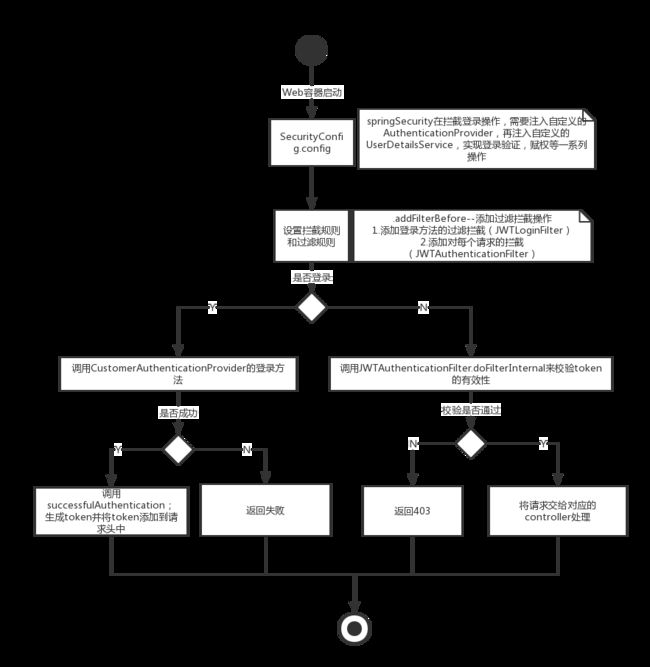1.说明
1.1 背景
慢慢构造一个微型的商城demo。使用的技术栈是SpringBoot+SpringCloud; 各个服务间的接口调用是有权限验证的。每个请求头包含token,通过token来 校验该请求是否合法
1.2 使用技术
-
springBoot 基础框架
-
SpringCloud
- eureka 服务与服务的注册中心
- Feign 负责服务间的调用
- zuul 向外暴露的服务网关
-
Spring Security 安全框架
-
ORM
- mybatis plus 对mybatis的进一步封装
-
redis 应用缓存、接口数据缓存
-
zookeeper 注册中心
-
rabbitMQ 消息队列
-
JWT 结合Spring Security使用,实现服务之间的鉴权。Spring Security负责请求的过滤拦截以及赋权, JWT负责判断该token是否过期
1.3 项目结构
├── README.md
├── demo-cache 缓存模块
├── demo-common 公共模块,包括切面,token认证等一些公共方法
├── demo-eureka 注册中心
├── demo-gateway 网关
├── demo-message 消息模块(kafka)
├── demo-parent.iml
├── demo-product 产品模块
├── demo-user 用户模块
├── demo.sql 初始化sql
└── pom.xml
1.4 JWT认证
1.4.1 JWT的认证流程
1.4.2 代码实现
- SpringSecurity配置
@Configuration
@EnableWebSecurity
@EnableGlobalMethodSecurity(prePostEnabled = true)
public class SecurityConfig extends WebSecurityConfigurerAdapter {
//private BCryptPasswordEncoder bCryptPasswordEncoder;
@Autowired
private UserDetailsService userDetailService;
public SecurityConfig() {
super();
}
@Bean
public BCryptPasswordEncoder bCryptPasswordEncoder(){
return new BCryptPasswordEncoder();
}
@Override
public void configure(AuthenticationManagerBuilder auth) throws Exception {
// auth.userDetailsService(userDetailsService).passwordEncoder(bCryptPasswordEncoder);
// ***注入自定义的provider ***,在权限验证的时候后实际走的是 CustomAuthenticationProvider.authenticate
auth.authenticationProvider(new CustomAuthenticationProvider(userDetailService, bCryptPasswordEncoder()));
auth.userDetailsService(userDetailService).passwordEncoder(bCryptPasswordEncoder());
}
@Override
protected void configure(HttpSecurity http) throws Exception {
//禁用 csrf
http.cors().and().csrf().disable().authorizeRequests()
//允许以下请求
.antMatchers("/login/**").permitAll()
// 所有请求需要身份认证
.anyRequest().authenticated()
.and()
// authenticationManager() 从IOC容器中获取。实际就是用户自定义注入的 CustomAuthenticationProvider
//拦截登录操作,
.addFilterBefore(new JWTLoginFilter("/login", authenticationManager()), UsernamePasswordAuthenticationFilter.class)
//拦截每一个请求,验证token是否有效
.addFilterBefore(new JWTAuthenticationFilter(authenticationManager()), UsernamePasswordAuthenticationFilter.class);
}
}
- 登录过滤拦截
这里需要注意的是,获取登录名、密码默认是通过get方式获取的,而且键名也是一定的 如果是从json中获取还需要将request的请求参数转换为json数据
/**
* token信息是存放在request的ThreadLocal里面的。当当前的request销毁,它会存放到session;所以在集群环境中,需要设置session同步;
*
*
*
* 拦截用户额login操作。继承 UsernamePasswordAuthenticationFilter
* 默认会执行方法:attemptAuthentication。
* authenticationManager,在SercurityConfig中自定义的方法。auth.authenticationProvider(new CustomAuthenticationProvider(userDetailsService, bCryptPasswordEncoder()));
* 表示login这个请求的权限验证会走 CustomAuthenticationProvider.authenticate这个方法
* 在此方法的逻辑是 setDetails(request, authenticationToken); 调用用户注入的UserDetailsService
* 1.UserDetailsService的作用调用loadByusername的通过唯一标识获取到用户的权限及密码信息。
* 2.再调用 authenticationManager.authenticate(authenticationToken)-->实际调用的是CustomAuthenticationProvider.authenticate 来判断参数中的密码与数据库中存储的密码是否相同
*/
public class JWTLoginFilter extends UsernamePasswordAuthenticationFilter {
private AuthenticationManager authenticationManager;
/**
*
* @param url 拦截的登陆URL地址
* @param authenticationManager
*/
public JWTLoginFilter(String url, AuthenticationManager authenticationManager) {
super();
//new AntPathRequestMatcher("/login", "POST"))
this.authenticationManager = authenticationManager;
}
@Override
public Authentication attemptAuthentication(HttpServletRequest request, HttpServletResponse response) {
//得到用户登陆信息,并封装到 Authentication 中,供自定义用户组件使用.
String username = request.getParameter("username");
String password = request.getParameter("password");
if (username == null) {
username = "";
}
if (password == null) {
password = "";
}
username = username.trim();
// GrantedAuthorityImpl
ArrayList authorities = new ArrayList<>();
UsernamePasswordAuthenticationToken authenticationToken = new UsernamePasswordAuthenticationToken(username, password, authorities);
// Allow subclasses to set the "details" property
setDetails(request, authenticationToken);
//实际调用CustomAuthenticationProvider.authenicate()方法
return authenticationManager.authenticate(authenticationToken);
}
/**
* 登陆成功后,此方法会被调用,因此我们可以在次方法中生成token,并返回给客户端
*
* @param request
* @param response
* @param chain
* @param authResult
*/
@Override
protected void successfulAuthentication(HttpServletRequest request,
HttpServletResponse response,
FilterChain chain, Authentication authResult) {
TokenAuthenticationService.addAuthenticatiotoHttpHeader(response,authResult);
}
}
- 自定义的权限解析器
主要功能看类注释
/**
* 自定义权限生成器
* JWTLoginFilter拦截后调用 CustomAuthenticationProvider.authenticate()方法。
* 1.调用自定义的UserDetailsService来判断用户传进来的密码与数据库中是否一致。
* 2.登录成功默认调用 JWTLoginFilter.successfulAuthentication()来生成对应的token
*
*
*/
public class CustomAuthenticationProvider implements AuthenticationProvider {
//构造方法传进来
private UserDetailsService userDetailsService;
private BCryptPasswordEncoder bCryptPasswordEncoder;
public CustomAuthenticationProvider(UserDetailsService userDetailsService, BCryptPasswordEncoder bCryptPasswordEncoder) {
this.userDetailsService = userDetailsService;
this.bCryptPasswordEncoder = bCryptPasswordEncoder;
}
/**
* 是否可以提供输入类型的认证服务
*
* 如果这个AuthenticationProvider支持指定的身份验证对象,那么返回true。
* 返回true并不能保证身份验证提供者能够对身份验证类的实例进行身份验证。
* 它只是表明它可以支持对它进行更深入的评估。身份验证提供者仍然可以从身份验证(身份验证)方法返回null,
* 以表明应该尝试另一个身份验证提供者。在运行时管理器的运行时,可以选择具有执行身份验证的身份验证提供者。
*
* @param authentication
* @return
*/
@Override
public boolean supports(Class authentication) {
return authentication.equals(UsernamePasswordAuthenticationToken.class);
}
/**
* 验证登录信息,若登陆成功,设置 Authentication
*
* @param authentication
* @return 一个完全经过身份验证的对象,包括凭证。
* 如果AuthenticationProvider无法支持已通过的身份验证对象的身份验证,则可能返回null。
* 在这种情况下,将会尝试支持下一个身份验证类的验证提供者。
* @throws UsernameNotFoundException
*/
@Override
public Authentication authenticate(Authentication authentication) throws UsernameNotFoundException {
// 获取认证的用户名 & 密码
String username = authentication.getName();
String password = authentication.getCredentials().toString();
//通过用户名从数据库中查询该用户
UserDetails userDetails = userDetailsService.loadUserByUsername(username);
//判断密码(这里是md5加密方式)是否正确
String dbPassword = userDetails.getPassword();
String encoderPassword = DigestUtils.md5DigestAsHex(password.getBytes());
if (!dbPassword.equals(encoderPassword)) {
throw new UsernameNotFoundException("密码错误");
}
// 还可以从数据库中查出该用户所拥有的权限,设置到 authorities 中去,这里模拟数据库查询.
ArrayList authorities = new ArrayList<>();
// authorities.add(new GrantedAuthorityImpl("ADMIN"));
Authentication auth = new UsernamePasswordAuthenticationToken(username, password, authorities);
return auth;
}
}
- Token生成与token的校验
/**
* 将jwt token 写入header头部
* 添加token刷新机制,当token还有30s过期的时候主动刷新token并存放到response的header中
* 为了安全起见,这里的token应该使用非对称加密,返回到客户端,当客户端下次再请求的时候拿着解密后的token来请求
* @param response
* @param authentication
*/
public static void addAuthenticatiotoHttpHeader(HttpServletResponse response, Authentication authentication) {
//生成 jwt
Claims claims = (Claims) Jwts.claims().put("aName", "aValue");
String token = Jwts.builder()
//生成token的时候可以把自定义数据加进去,比如用户权限
.claim(AUTHORITIES, "ROLE_ADMIN,AUTH_WRITE")
.setSubject(authentication.getName())
// .setClaims(claims)
.setExpiration(new Date(System.currentTimeMillis() + EXPIRATIONTIME))
.signWith(SignatureAlgorithm.HS512, SECRET)
.compact();
//把token设置到响应头中去
response.addHeader(HEADER_STRING, TOKEN_PREFIX + token);
}
/**
* 从请求头中解析出 Authentication
* @param request
* @return
*/
public static Authentication getAuthentication(HttpServletRequest request, HttpServletResponse response) {
// 从Header中拿到token
String token = request.getHeader(HEADER_STRING);
if(token==null){
return null;
}
//在JWT的playload中,包含了token的过期时间、权限等信息。如果token过期在parseClaimsJws方法会抛出 ExpiredJwtException
Claims claims = null;
try {
claims = Jwts.parser().setSigningKey(SECRET)
.parseClaimsJws(token.replace(TOKEN_PREFIX, ""))
.getBody();
} catch (Exception e) {
return null;
}
String auth = (String)claims.get(AUTHORITIES);
// 得到 权限(角色)
List authorities = AuthorityUtils.
commaSeparatedStringToAuthorityList((String) claims.get(AUTHORITIES));
//得到用户名
String username = claims.getSubject();
//得到过期时间
Date expiration = claims.getExpiration();
long expirationTime = expiration.getTime();
//判断是否过期
// Date now = new Date();
// if (now.getTime() > expiration.getTime()) {
//
// throw new UsernameNotFoundException("该账号已过期,请重新登陆");
// }
//自动刷新token机制,如果token的有效时间还剩下30s,自动刷新token并将token返回出去并写到request中
long currentTimeMillis = System.currentTimeMillis();
if (expirationTime - currentTimeMillis <= TOKEN_FLUSH_SEC) {
try {
token = flushToken(claims);
//把token设置到响应头中去
response.addHeader(HEADER_STRING, token);
} catch (Exception e) {
e.printStackTrace();
}
}
if (StringUtils.isEmpty(username)) {
//return new UsernamePasswordAuthenticationToken(username, null, authorities);
throw new UsernameNotFoundException("该账号已过期,请重新登陆");
}
//可以将用户的账号、权限等信息缓存到request中,当请求到了具体的controller的时候,需要这些参数的时候从request中再把它拿出来即可
request.setAttribute("userCode", username);
return new UsernamePasswordAuthenticationToken(username, null, authorities);
}
1.5 注意点
- 服务间调用如何将token设置到请求头中
服务间的调用时通过feign来做的,但是如何将token设置到feign的请求头里面。如下:
/**
* @author: code4fun
* @date: 2018/8/9:上午11:54
* 处理Feign调用其他系统的时候,往请求头里面加上 token这个参数
*/
@Configuration //RequestInterceptor
public class FeginInterceptor implements RequestInterceptor {
public static String TOKEN_HEADER = "token";
@Override
public void apply(RequestTemplate template) {
template.header(TOKEN_HEADER, getHeaders(getHttpServletRequest()).get(TOKEN_HEADER));
}
private javax.servlet.http.HttpServletRequest getHttpServletRequest() {
try {
// RequestContextHolder.getRequestAttributes().
return ((ServletRequestAttributes) RequestContextHolder.getRequestAttributes()).getRequest();
} catch (Exception e) {
return null;
}
}
private Map getHeaders(javax.servlet.http.HttpServletRequest request) {
Map map = new LinkedHashMap<>();
Enumeration enumeration = request.getHeaderNames();
while (enumeration.hasMoreElements()) {
String key = enumeration.nextElement();
String value = request.getHeader(key);
map.put(key, value);
}
return map;
}
}
- Feign调用超时设置
#feign的调用超时设置
ribbon:
ReadTimeout: 60000
ConnectTimeout: 60000
- 服务的application.ame命名规则 application.name的命名规则应当使用 - 来分割,如果使用 _ 的话,在feignclient端注入服务名的时候会爆unknow host id的异常
1.6 获取刷新后的token
这里使用的事aop(AfterReturning)的方式来拦截。具体定义如下
1.6.1 生命切面注解
/**
* 自动刷新token注解
* 写在每个请求当方法上面,当token还有30秒过期的时候,刷新token并将token返回到返回参数列表中来
* @author: code4fun
* @date: 2018/9/1:下午5:17
*/
@Retention(RetentionPolicy.RUNTIME)
@Target(ElementType.METHOD)
public @interface FlushTokenAspect {
String value() default "";
}
1.6.2 注解的具体实现
/**
* token刷新注解实现
* @author: code4fun
* @date: 2018/9/1:下午5:21
*/
@Component
@Aspect
public class FlushTokenImpl {
private Logger logger = LoggerFactory.getLogger(FlushTokenImpl.class);
@Pointcut("@annotation(cn.com.demo.common.aop.token.FlushTokenAspect)")
public void point(){
}
@Before("point()")
public void doBefore(JoinPoint joinPoint) {
logger.info("---------->shu前置通知");
}
/**
* 拦截请求返回
* 如果response的含有token(刷新后的token),将token拼接到返回体中
* 这里返回的token最好使用非对称加密的方式。客户端拿到加密后的token解密完再来请求
* @param obj
*/
@AfterReturning(returning = "obj", pointcut = "point()")
public void doAfterReturning(Object obj) {
//获取当前的请求信息
ServletRequestAttributes attributes = (ServletRequestAttributes) RequestContextHolder.getRequestAttributes();
HttpServletResponse response = attributes.getResponse();
//如果response的header中已经包含可token,说明此次请求token已经刷新,需要将token返回到客户端
String token = response.getHeader("token");
if (!StringUtils.isEmpty(token)) {
((ResponseBody) obj).setToken(token);
}
}
}
因为项目分模块设计的原因,注解模块不在对应的业务层上面。所以应该要在对应的业务系统引入; 具体如下:
@Import({
cn.com.demo.common.aop.token.FlushTokenImpl.class
})
